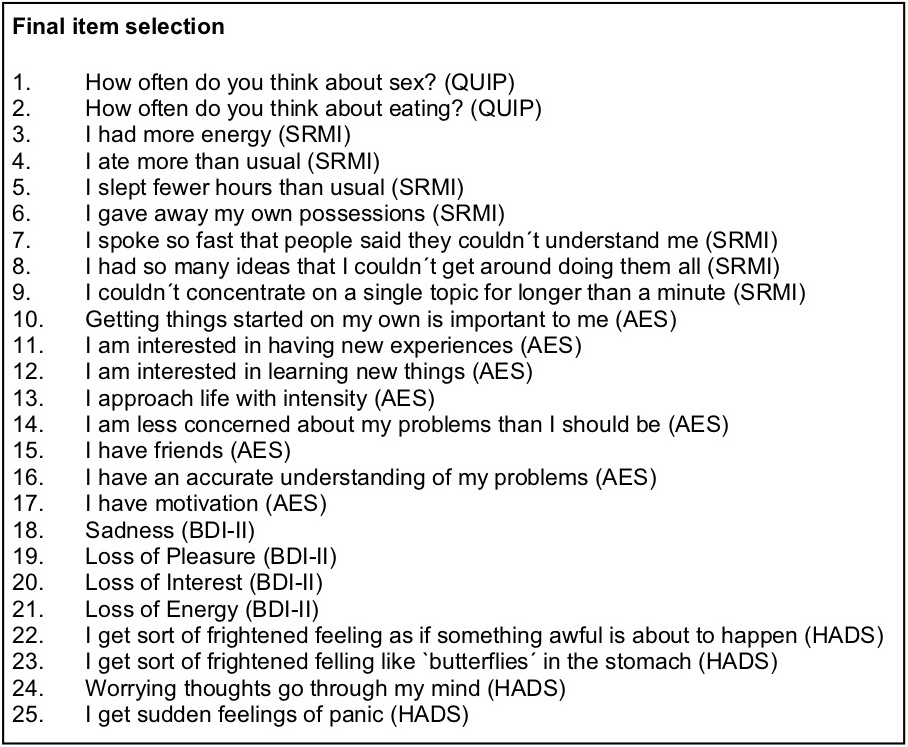Session Information
Date: Wednesday, September 25, 2019
Session Title: Non-Motor Symptoms
Session Time: 1:15pm-2:45pm
Location: Agora 3 West, Level 3
Objective: To develop a novel screening tool by pooling items from international self-assessment scales detecting psychoaffactive states such as mania, apathy, anxiety, depression and impulse control disorders in patients with Parkinson´s disease (PD).
Background: For the past years motor symptoms in PD have been the focus in clinical and experimental research. Recently, non-motor symptoms, specifically psychoaffective alterations such as mania, apathy, anxiety, depression, and impulse control disorders moved into the center of interest. A correct description of the psychoaffective state is particularly important before deep brain stimulation (DBS) of the subthalamic nucleus, as this might have consequences for surgical indication. Using the full arsenal of different scales is time consuming and many items are redundant. To reduce the burden of the patients, pooling of the relevant items into one screening tool might be advantageous.
Method: 307 inpatients with PD (medium age= 66,01 years, SD= 10.18; 209 m, 98 f) were retrospectively analyzed. All patients underwent standardized neuropsychiatric testing including the German versions of SRMI [1] (mania; 48 items), AES [2] (apathy; 18 items), HADS [3] (anxiety and depression; 14 items), BDI-II [4] (depression; 21 items), QUIP-RS [5] (impulse control disorders; 28 items) in order to assess the indication for DBS at the University Hospital of Cologne from 2014 to 2018. Response patterns were analyzed based on classical test theory. Items that were negated in ≥80% of the PD patients in this preliminary analysis were excluded due to missing relevance in PD. The cognitive status was measured by MMSE [6], MOCA [7] and PANDA [8].
Results: From a total of 129 items in five questionnaires, 104 were identified as irrelevant. The remaining 25 items are displayed in table 1.
Conclusion: Preliminary results show that a reduced item selection might capture significant elements of the psychoaffective state in PD patients. Further analysis is needed to confirm validity of this new screening tool in PD patients.
References: 1 Manie Selbstbeurteilungsskala, Krüger et al. 1997; 2 Apathie Evaluationsskala, Lueken et al. 2006; 3 Hospital Anxiety and Depression Scale-Deutsche Version, Hermann-Lingen et al. 1995; 4 Beck´s Depression Inventory II, Hautzinger et al. 1995; 5 Questionnaire for Impulsive-Compulsive Disorders in Parkinson´s Disease-Rating Scale, Weintraub et al. 2012; 6 Mini Mental Status Test, Kessler et al. 1990; 7 Montreal Cognitive Assessment, Nasreddine et al. 2005; 8 Parkinson Neuropsychometric Dementia Assessment, Kalbe et al. 2005
To cite this abstract in AMA style:
C. Schedlich-Teufer, M. Sommerauer, S. Jost, S. Schnitzler, H. Dafsari, E. Kalbe, J. Kessler, M. Barbe. A new screening tool to detect psychoaffective states in patients with Parkinson´s disease [abstract]. Mov Disord. 2019; 34 (suppl 2). https://www.mdsabstracts.org/abstract/a-new-screening-tool-to-detect-psychoaffective-states-in-patients-with-parkinsons-disease/. Accessed December 14, 2025.« Back to 2019 International Congress
MDS Abstracts - https://www.mdsabstracts.org/abstract/a-new-screening-tool-to-detect-psychoaffective-states-in-patients-with-parkinsons-disease/

